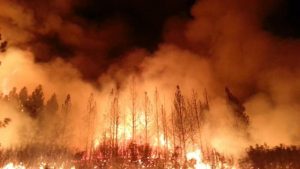 Struck by fire and flood, first from two hurricanes enhanced by climate change, and then by heat and drought enhanced fires, our urge is to rapidly assist, fix and rebuild. A more thoughtful response should also address what exactly should be fixed, and how and where to rebuild with greater resilience. For Houston, Florida, Puerto Rico, and Napa and Sonoma Counties, these are gut-wrenching questions with few easy answers.
Struck by fire and flood, first from two hurricanes enhanced by climate change, and then by heat and drought enhanced fires, our urge is to rapidly assist, fix and rebuild. A more thoughtful response should also address what exactly should be fixed, and how and where to rebuild with greater resilience. For Houston, Florida, Puerto Rico, and Napa and Sonoma Counties, these are gut-wrenching questions with few easy answers.
The typical and very human response — quick rebuilds — is attractive to construction companies looking for work and banks providing short-term construction loans. Politicians and communities like them because they make for good short-term (but non-recurring) jobs and economic stimulus. However, when all is done, what we have rebuilt is often no more resilient than what was destroyed. Ultimately it begs whether we can afford “same-as-before” rebuilds for what are increasingly becoming more than once-in-a-lifetime natural disasters.
Better building codes, zoning ordinances and infrastructure are only part of the solution. Ultimately, those who own and invest in the underlying land, buildings and the businesses that operate there will bear the costs of disruption and rebuilding. They should be revaluing their asset holdings and investments and remediating high-risk assets and/or replacing them with more resilient ones.
Elected officials, taxpayers and public policy will play an integral role in whether investors shift from short-term thinking to long-term sustainability. If long-term investors believe that elected officials and taxpayers will bail them out, they will not change their behavior. Together the right messaging from public interest groups to our large institutional investors can drive the market toward investing in more resilient infrastructure, lowering the cost of future rebuilds, enhancing the value of the underlying real property assets, and protecting the jobs that sit on top of those assets. Thoughtful investors should already be incorporating resilience criteria in choosing investments, be they in land and buildings, and energy, water and transportation infrastructure. It’s just smart business.
Let’s make sure that as we rebuild, we are doing so in a manner that makes our communities better and safer places to live. Statistically, every $1 spent on mitigation saves $4 of losses. Even as we race to assist those in need, let’s be smarter in helping us all rethink the rebuilding process with greater resilience in mind.
A very timely and thoughtful discussion. I and my brain trust have been trying to figure out what to do about Puerto Rico. The sad concensus is: there is nothing… Read more »
While it makes sense to put the proper price signals into the market so people don’t just rebuild in flood or fire zones, the real need is to put the… Read more »
I’m currently working on this issue in the Caribbean. There is a mechanism with Public-Private Partnerships. Including conversation with insurance companies about Risk Management and how to reduce future losses. Flordia after… Read more »